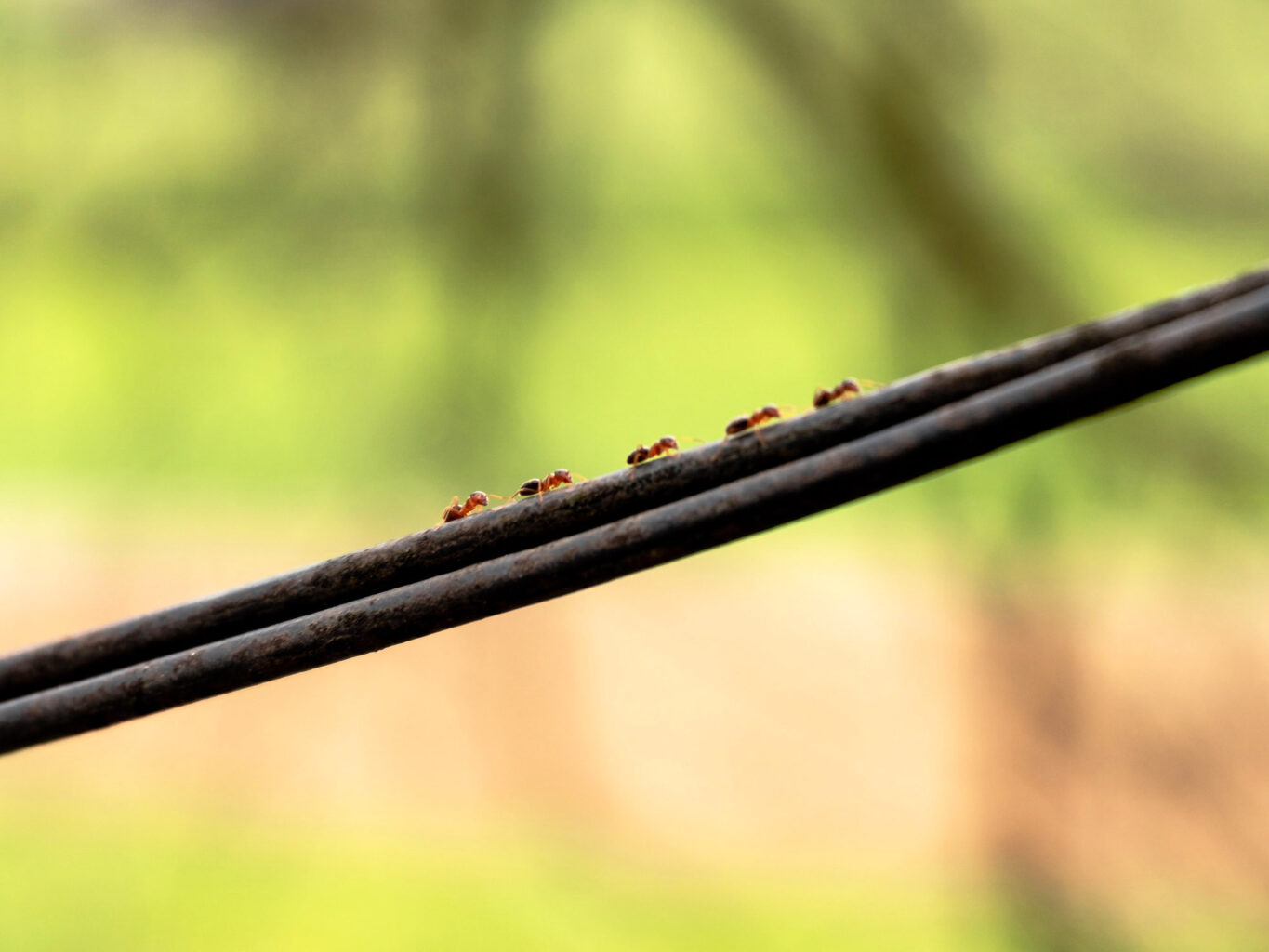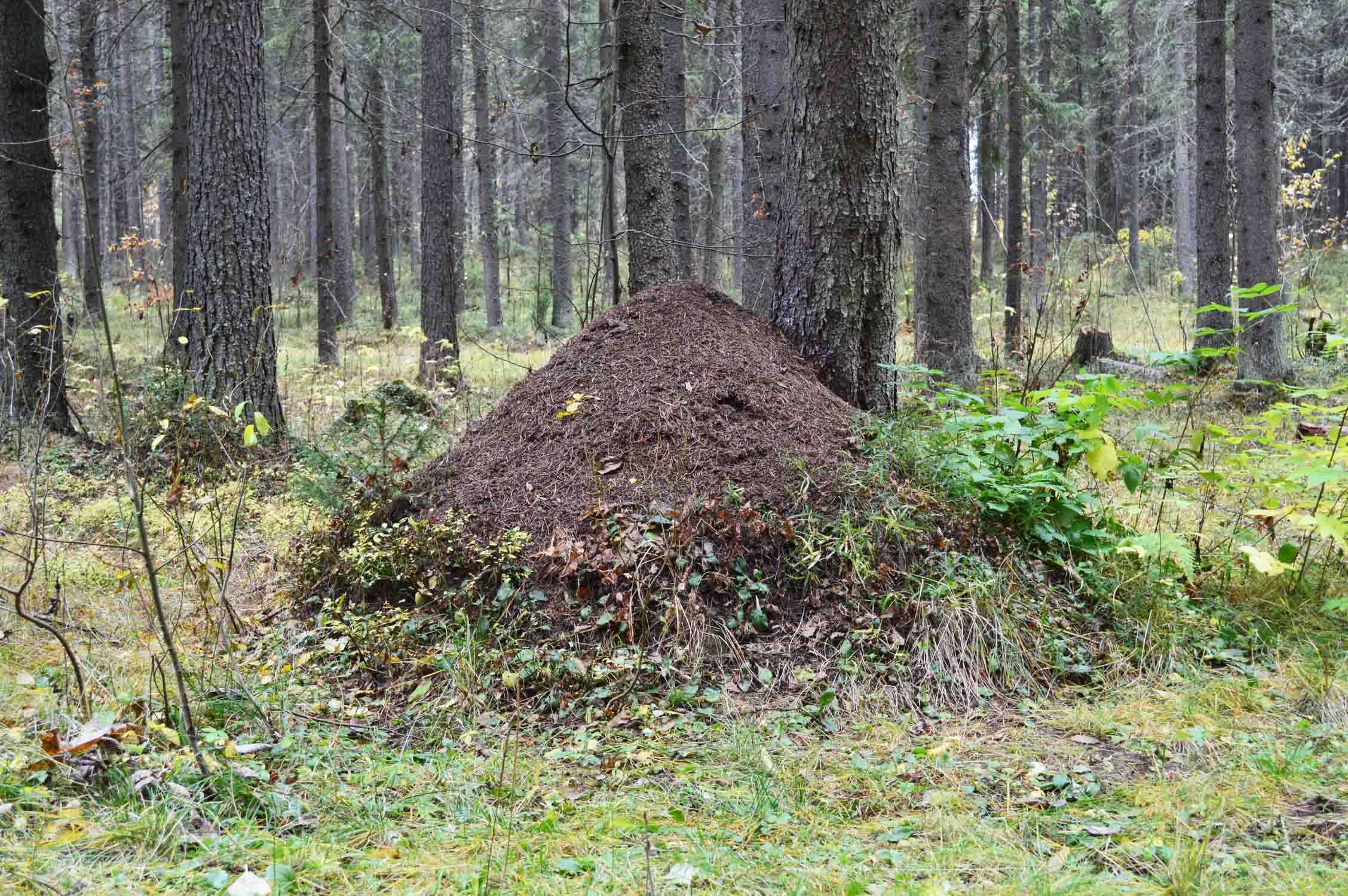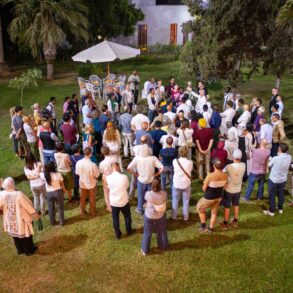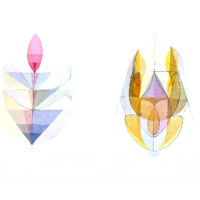We are usually not aware of the role of forests in agriculture. The ordering power of its primary inhabitants, ants, is also poorly known. Peter Stühl summarized Raimund Remer’s lecture on these remarkable beings.
Currently, 116 ant species are known in Germany, 8 of which have been introduced, and 58 are registered on the Red List of Endangered Species. Some institutes, such as the Angewandte Zoologie [Applied Zoology Institute] in Würzburg, have long been looking for traces of the creative life in nature. Particularly Karl Gößwald, Professor of Zoology, propagated the use of forest ants to promote the forest’s resistance to pests in a biological-ecological way. By multiplying ants, we could achieve tremendous help for the forest. «A particularly striking proof of the predatory activity of red forest ants is the so-called green oases saved by them during insect calamities in the middle of the forest eaten bare all around by, e.g., nun moths, pine beauties, and pine loopers.» (Karl Gößwald, Die rote Waldameise [The Red Forest Ant]. Publisher Metta-Kinau, Lüneburg) Many ant species live to protect trees. For more than 200 years, scientists and foresters have been working on forest ants.
The Forest and its Astrality
The little red forest ant is known for «rebuilding a permanently healthy and fertile forest» (Gößwald). The ethereal-organic forces of the forest arise from the socialization of the tree species, soils, and places. The ants, bees, and butterflies can use nectar and pollen from the flowers even before bark louse species are abundant. The forest habitat has animal beings corresponding to the place. There, the desired ant species also do something special. Tiny areas would have to be omitted in vast forests to enable light forces for plants and insect species. A designed forest border is particularly valuable because it allows for various habitats. This needs help and care. Today, the forest cannot survive in self-authorized succession. The human hand is required worldwide. «The regulation of the forest is simply part of agriculture and must basically be considered from the spiritual side according to its full scope. The correct astralization of the air is produced by the world of flying insects. This astralization of the air interacts with the forest, which directs astrality in the right way, just as in our body, the blood is guided in the right way by certain forces.» (Bernd Hölldobler, Auf den Spuren der Ameisen [In the Footsteps of Ants]. Springer Spektrum, 2015)
Forests have a longing for the proper astralization of their air for their time and place. The four ant species contribute to this: in the plain and middle landscape forests, the little red forest ant and the meadow ant; in the mountains, the mountain ant; and, in high mountains up to the montane levels, the high mountain forest ant. These four ant species emit noticeable, pleasant scents in forests. They have many queens per nest. Through a peaceful, helping Will, colonies are formed to develop sufficient colonies for the areas. This is visible in the trees’ growth and designed roots. But the forest must be constantly helped to live. Almost 100 years ago, Rudolf Steiner gave an important hint: «And since the earth is also gradually changing due to all sorts of climatic and cosmic influences, one should have the heart when one sees that vegetation becomes miserable not to do all sorts of experiments only in the fields and for the fields, but to increase the forest areas nearby. […] Regulation of the forest in areas already intended for forestation is simply part of agriculture and must basically be considered from the spiritual side according to its full scope.» (Agricultural Course, l6.6. after the 8th lecture, questions and answers)

The Acquaintance
The little red forest ant is predominant in the North German lowlands and low mountain ranges, with up to a hundred queens per nest. Another species is the giant red forest ant, with only one queen per colony. With more prolonged contemplation, you can see that their trails are shaped a little differently. In part, this species changes its nests from summer to winter nests and migrates back in the spring when it gets warm. Nests are fought within a radius of about 200 meters in their territory. The queen can live about twenty years and lays about a million eggs annually.
Ants protect themselves in nests without supplies from the winter cold. They store nutrients in their intestines. The colder it gets, the deeper and closer together in the nest they rest. Rooms are shaped for winter life. They suffer through destruction when the upper layers of the nest are opened by animals looking for food. The ants survive the unrest surprisingly well. Basically, forest ants build their nests on the surface from needles, wood, and sandy soil. Openings for air movement are opened or closed depending on the weather. If you watch the nest a little, you quickly read their ‹newspaper›. If rain soon comes, the responsible ‹engineers› plan briefly and quickly but purposefully and begin to rebuild the corresponding road gates. At the last drop of rain, they are already rebuilding again. It is constantly moving, depending on the light and heat conditions. At the southern forest edges, the above-ground parts of the nest are flatter. In the shady forest, heat is gained by the height of the nest. And next to the nest mound, which is so high up, there are sand walls on the area around the nest. They use it to build loose layers for paths and chambers. Also, suitable rooms are made for the queens of the forest ants, almost in the pattern of the pyramids of Giza. Because the so-called ‹descending corridor› leads into the depths to the ‹large rock chamber›, which has an active air shaft, this secure space, which was created about 4500 years ago, does not suffer from timber transport. In rooms, rock chambers ‹in miniature›, the ant queen is guided by her workers to hand over her many eggs to the caregivers.
A Second Life
The warmed eggs hatch tiny larvae with no legs, antennae, or eyes. Hungry, they wait for food, which is offered to them by trained caregivers. The larvae detach from their outer skin, under which new skins form, sometimes four or even sixfold. The workers compost the skins in the forest. Suddenly, the will of these hungry larvae changes. The renunciation of further pleasure now creates new life. They transform into a pre-pupa and spin a silken cocoon of many fine threads around them. An exact and typical wrapping forms like a precisely shaped ‹coffin›. A new body is prepared from transformed mucous substances. Although not yet used for breathing, a barely visible ring with fine central threads on the anterior cocoon has emerged. It is a valve to use air later and then escape from the cocoon as an adult ant.

In recent times, there has been a steady decline in ants in the forests, even more so than in other insect species. The reasons for this are, among other things, the compaction of the soil by immense machines and the removal of older, well-living trees with high crowns, which are usually the most valuable food basis for the forest ants. The ordering forest ants are part of the healthy life of a permanent forest. They contribute to the useful life of the forests. But they now need the help and support of the people.
Translation Monika Werner









